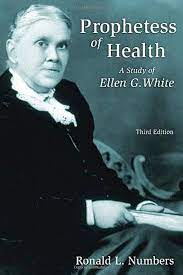Articles/Essays – Volume 11, No. 1
Timing, Context and Charisma | Ronald L. Numbers, Prophetess of Health: A Study of Ellen G. White
Seldom does the motivation for a book begin with a serendipitous finding. Such, however, was the case for this partial biography of Ellen G. White, the founder of Seventh Day Adventism. The author, a specialist in history of medicine, discovered an unusually close correspondence between the language of Ellen White’s Christian Temperance and Bible Hygiene and an earlier work of Dr. L. B. Coles’ Philosophy of Health. Mrs. White had steadfastly maintained that her religious and health ideas were the undiluted by-products of inspiration. She disclaimed any significant indebtedness to the works of health reformers like Coles. From this initial discovery of evidence in support of secular influence on the development of the Adventist movement, the investigation broadened and was finally published.
The author, reared as a Seventh Day Adventist, doesn’t seem to have an axe to grind. The work is not apologetic, but neither is it intended as a frontal assault upon the tenets of Seventh Day Adventism. Even though serious questions are raised about some of the secular roots of Mrs. White’s prophetic inspiration, she emerges as a woman whose indefatigable efforts provide impressive health dividends to her people. Whatever one’s emotional response to the conclusions of the book, most will agree that there is evidence of fairness (“honest persons can look at the same evidence and see fundamentally different things”), courage and impressive documentation.
The most disappointing aspect of the book is the author’s recurrent, but brief, psychological diagnoses of Mrs. White. Al though the author denies both the inclination or expertise to delve into the mental health of Ellen White, he finds it difficult to restrain the impulse to entertain, though obliquely, psychological hypotheses for her behavior. Repeatedly, he refers to her “trou bled mind,” “deep despair,” “terrible feelings of guilt,” and then links these to the beginnings of her religious dreams. He cites instances of her losing touch with the world; collapsing on the floor; temporary loss of eyesight, speech and hearing; fainting spells; and being struck over the heart with a ball of fire.
After stimulating the imagination of the reader by these brief, suggestive, psycho historical forays, he withdraws to safer ground. By such a tactic he is able to have it both ways. Unwilling or unable to give a thoroughgoing psychological analysis, he lays suggestive groundwork in the mind of the reader for the “validity” of a psychological explanation of her religious behavior. Many readers will fail to realize how difficult it is to arrive at psychological profiles of the living that are acceptable to different schools and practitioners; retrospective analysis of the dead is doubly difficult. Ultimately, Numbers retreats to a more conservative social learning explanation for Mrs. White’s spiritual experiences: her social milieu was full of visionary models, among them Joseph Smith.
The major theme of the book revolves around the charge that the founder of Seventh Day Adventism borrowed, from con temporary religious colleagues, health re formers, and other movements (e.g., phrenology), ideas which she had attributed to personal inspiration. Although some of the evidence is circumstantial, the author builds a well-documented case for substantial indebtedness on the part of Mrs. White to the Health Reform movement. A comparative analysis of texts, particularly the work of L. B. Coles, leaves little room for alternative explanations to the borrowing thesis. Moreover, there is indisputable evidence that she was influenced, as were many others, by the phrenological movement. For example, her fears that hair pieces and wigs worn by women inflamed the passions by heating the base of the brain had definite phrenological overtones. Such borrowing would not have serious implications for Seventh Day Adventism except for Mrs. White’s persistent insistence that her religious and health ideas were independent of human influence.
For Mormons, particularly Mormon historians, the book is not only interesting but a rich source of ideas. The restoration grew out of a temporal and spatial context overlapping the emergence of the roots of the Adventist movement. Temperance, revelation, prophets, adventism, persecution—these and other interests were shared concerns of the two organizations. Their common and differential responses to these matters and to the general secular culture make an interesting study in comparative religion.
A Latter-day Saint cannot help but reflect that Joseph Smith, who of course claimed heavenly inspiration, was also sensitive to the movements and conditions of his time. The extent to which any specific statement or idea is drawn directly from the divine source of knowledge, or prompted by ideas and values in the surrounding environment, or is some mixture of the two, is a question that believers have had to wrestle with from at least as long ago as the Biblical prophets. Many religious believers have found it quite unnecessary to believe that the prophets operated in a vacuum by ignoring the sur rounding culture. On the other hand, to say that they simply took over existing notions and restated them seems a naive reduction ism that fails to consider the nature of all creativity, the different ways in which in spiration can occur, and the importance of timing, of context and of charisma. While continuing to think through the implications of such ideas, readers of this book will learn much about the fads, enthusiasms and genuine religious commitment of many nineteenth-century Americans.
Prophetess of Health: A Study of Ellen G. White. By Ronald L. Numbers. New York: Harper and Row publishers, 1976. 271 pp., $10.00.


 Back to full Issue
Back to full Issue

